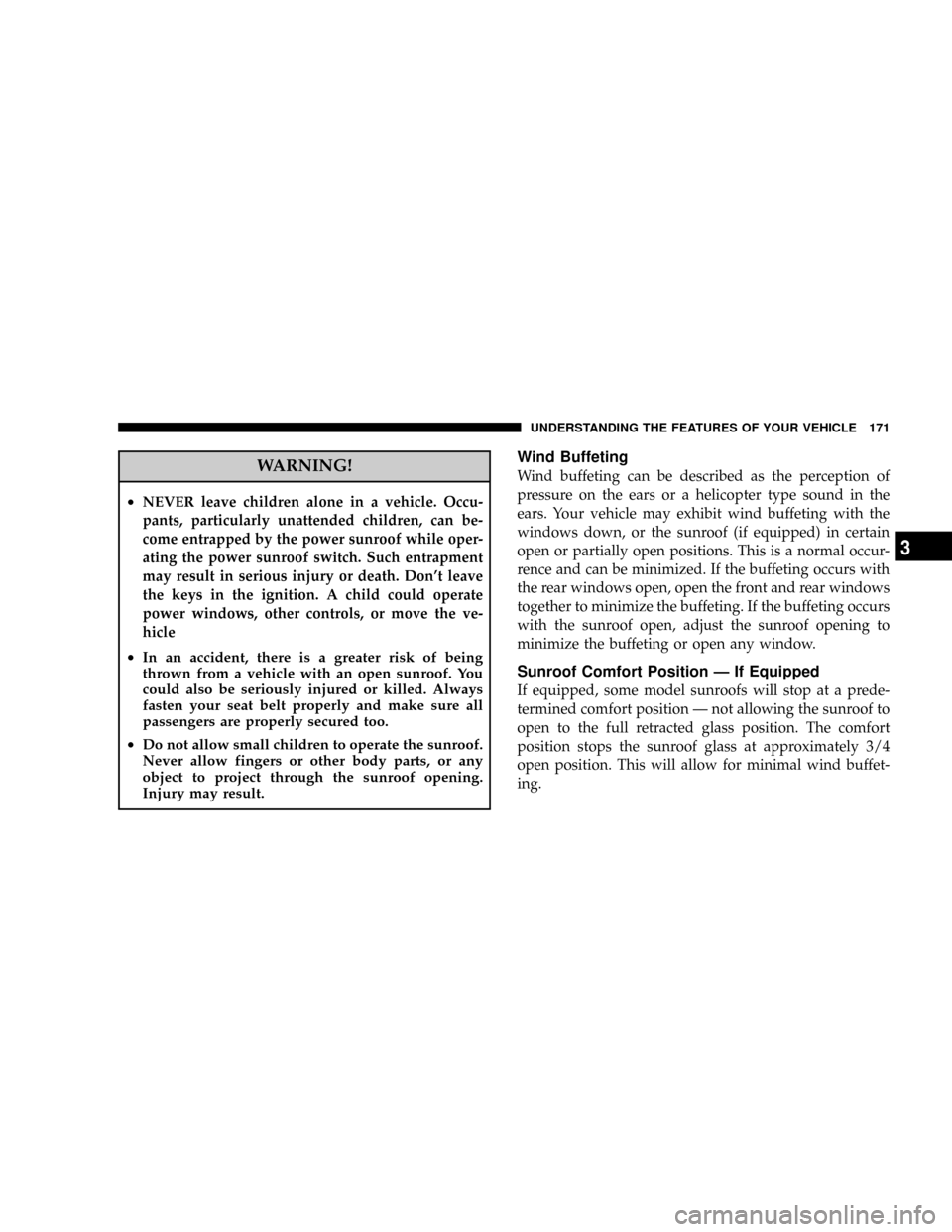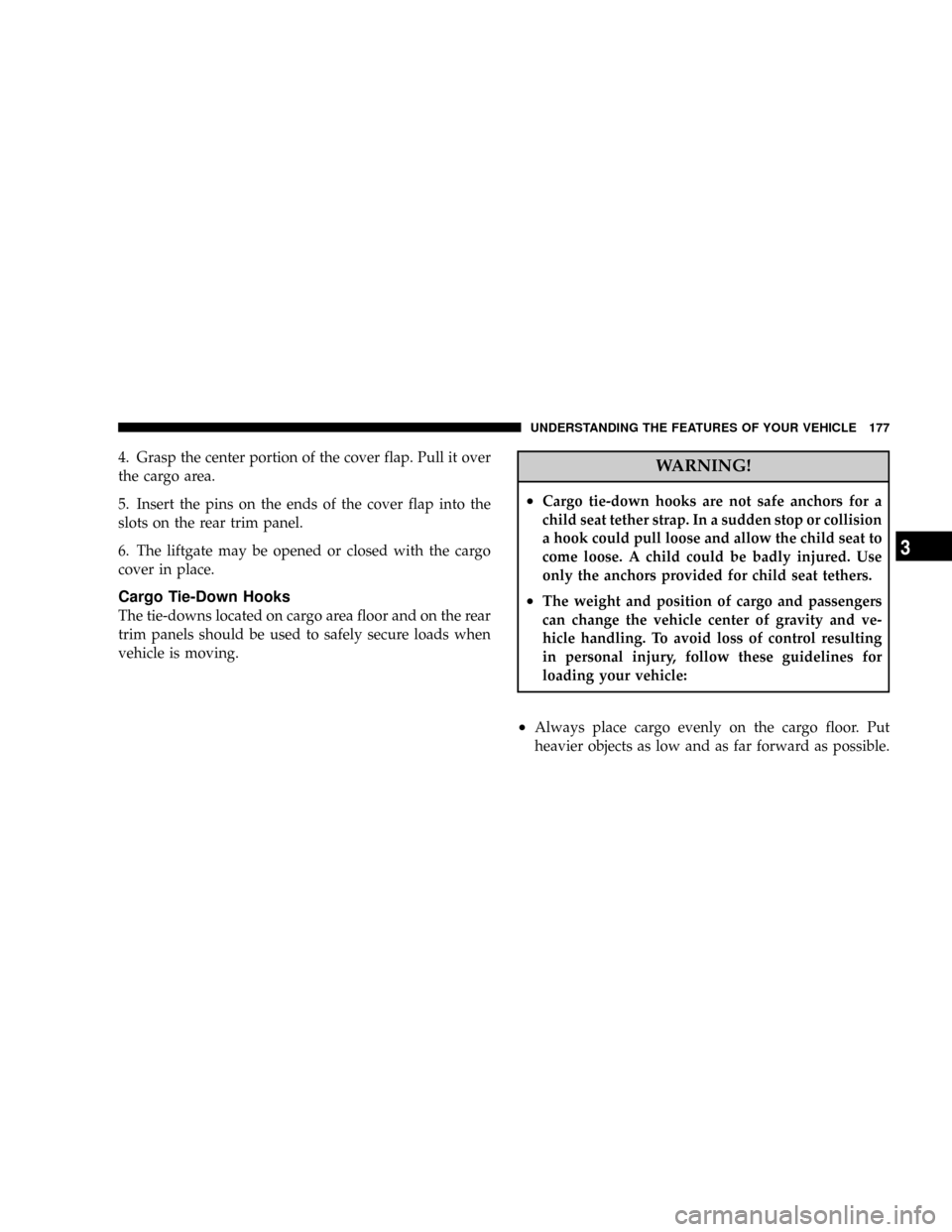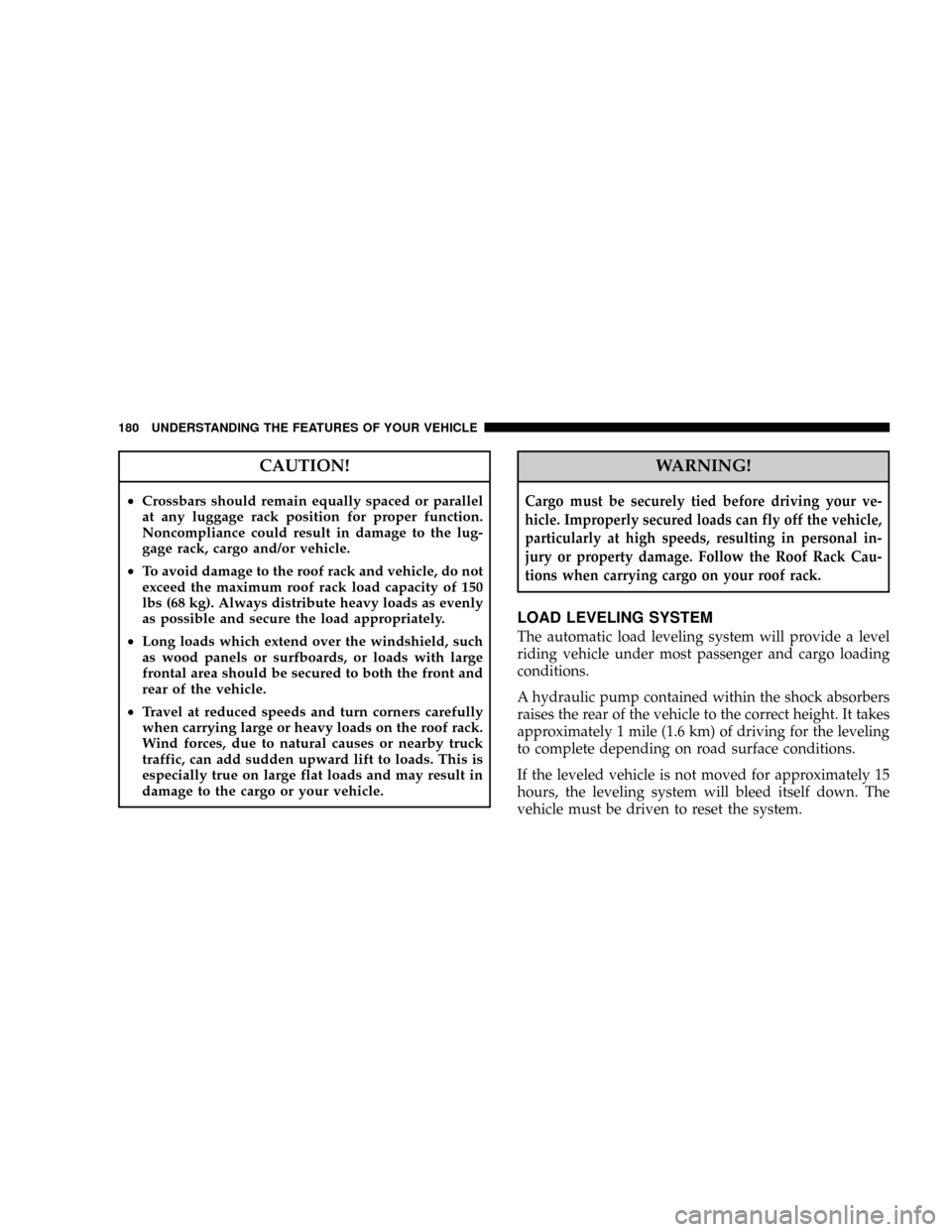CHRYSLER PACIFICA 2008 1.G Owners Manual
Manufacturer: CHRYSLER, Model Year: 2008, Model line: PACIFICA, Model: CHRYSLER PACIFICA 2008 1.GPages: 457, PDF Size: 6.7 MB
Page 171 of 457

WARNING!
²NEVERleave children alone in a vehicle. Occu-
pants, particularly unattended children, can be-
come entrapped by the power sunroof while oper-
ating the power sunroof switch. Such entrapment
may result in serious injury or death. Don't leave
the keys in the ignition. A child could operate
power windows, other controls, or move the ve-
hicle
²In an accident, there is a greater risk of being
thrown from a vehicle with an open sunroof. You
could also be seriously injured or killed. Always
fasten your seat belt properly and make sure all
passengers are properly secured too.
²Do not allow small children to operate the sunroof.
Never allow fingers or other body parts, or any
object to project through the sunroof opening.
Injury may result.
Wind Buffeting
Wind buffeting can be described as the perception of
pressure on the ears or a helicopter type sound in the
ears. Your vehicle may exhibit wind buffeting with the
windows down, or the sunroof (if equipped) in certain
open or partially open positions. This is a normal occur-
rence and can be minimized. If the buffeting occurs with
the rear windows open, open the front and rear windows
together to minimize the buffeting. If the buffeting occurs
with the sunroof open, adjust the sunroof opening to
minimize the buffeting or open any window.
Sunroof Comfort Position Ð If Equipped
If equipped, some model sunroofs will stop at a prede-
termined comfort position Ð not allowing the sunroof to
open to the full retracted glass position. The comfort
position stops the sunroof glass at approximately 3/4
open position. This will allow for minimal wind buffet-
ing.
UNDERSTANDING THE FEATURES OF YOUR VEHICLE 171
3
Page 172 of 457

Sunroof Maintenance
Use only a non-abrasive cleaner and a soft cloth to clean
the glass panel.
ELECTRICAL POWER OUTLETS
There are two 12 volt power outlets located on the
instrument panel below the radio. The driver's side outlet
is controlled by the ignition switch and the passenger
side outlet is connected directly to the battery. The
driver's side outlet will also operate a conventional cigar
lighter unit (if equipped with an optional Smoker's
Package).
A third outlet is located on the back of the front center
console near the floor, and is also controlled by the
ignition switch.
A fourth outlet is located on the driver's side, in the rear
cargo area and is also controlled by the ignition switch.
Front Power Outlets
172 UNDERSTANDING THE FEATURES OF YOUR VEHICLE
Page 173 of 457

The outlets include tethered caps labeled with a key or
battery symbol indicating the power source. The passen-
ger side instrument panel and center console outlets are
powered directly from the battery, items plugged into
these outlets may discharge the battery and/or prevent
engine starting.
The passenger side and center console outlets are pro-
tected by an automatic reset circuit breaker. The auto-
matic circuit breaker restores power when the overload is
removed.
NOTE:If desired, the fourth power outlet in the rear
cargo area can be converted by your authorized dealer to
provide power with the ignition switch in the OFF
position.Electrical Outlet Use With Engine Off
CAUTION!
²Many accessories that can be plugged in draw power
from the vehicle's battery, even when not in use (i.e.
cellular phones, etc.). Eventually, if plugged in long
enough, the vehicle's battery will discharge suffi-
ciently to degrade battery life and/or prevent engine
starting.
²Accessories that draw higher power (i.e. coolers,
vacuum cleaners, lights, etc.), will degrade the battery
even more quickly. Only use these intermittently and
with greater caution.
²After the use of high power draw accessories, or long
periods of the vehicle not being started (with accesso-
ries still plugged in), the vehicle must be driven a
sufficient length of time to allow the alternator to
recharge the vehicle's battery.
²Power outlets are designed for accessory plugs only.
Do not hang any type of accessory or accessory bracket
from the plug. Improper use of the power outlet can
cause damage.
UNDERSTANDING THE FEATURES OF YOUR VEHICLE 173
3
Page 174 of 457

CUPHOLDERS
Front Seat Cupholders
The cupholders are located in the forward edge of the
center console. Push down on the forward edge of the
console to release the cupholders. Press the cover up
when the cupholders are no longer needed.
Second Row Seat Cupholders
On vehicles equipped with five passenger seating the
second row seat cupholders are located in middle of the
seatback armrest. Pull down on the armrest to access the
cupholders. Push the armrest up when the cupholders
are no longer needed.
Six Passenger Seating CupholdersFive Passenger Seating Cupholders
174 UNDERSTANDING THE FEATURES OF YOUR VEHICLE
Page 175 of 457

On vehicles equipped with six passenger seating the
second row seat cupholders are located in the forward
edge of the center console located between the second
row seats. Push down on the forward edge of the console
to release the cupholders. Press the cover up when the
cupholders are no longer needed.
Third Row Seat Cupholders Ð If Equipped
There are cupholders located in each rear trim panel for
the third row seat passengers.
STORAGE
Console Features
The center consoles may be equipped with a tissue
holder mounted on the underside of the cover. The
bottom of the console bins may also have built in holders
for compact discs or cassette tapes.
Rear Cargo Storage Bin Ð If Equipped
The storage bin is located in the floor of the rear cargo
area. To open lift up on the handle.
Rear Storage Bin
UNDERSTANDING THE FEATURES OF YOUR VEHICLE 175
3
Page 176 of 457

Retractable Cargo Area Cover Ð If Equipped
To cover the cargo area:
1. Fold down the third row seatbacks.
2. Unfold the cargo cover extensions and lock into place.
3. Insert the pins on the ends of the cover into the slots
located on the trim panel behind the second row seat-
backs.
4. Grasp the center portion of the cover flap. Pull it over
the cargo area.
5. Insert the pins on the ends of the cover flap into the
slots on the rear trim panel.
6. The liftgate may be opened or closed with the cargo
cover in place.WARNING!
In an accident a cargo cover loose in the vehicle could
cause injury. It could fly around in a sudden stop and
strike someone in the vehicle. Do not store the cargo
cover on the cargo floor or in the passenger compart-
ment. Remove the cover from the vehicle when taken
from its mounting. Do not store in the vehicle.
Stowed Position
1. Fold down the third row seatbacks.
2. Fold the cargo cover extensions to their stowed posi-
tion and lock into place.
3. Insert the pins on the ends of the cover into the slots
located on the trim panel behind the third row seatbacks.
176 UNDERSTANDING THE FEATURES OF YOUR VEHICLE
Page 177 of 457

4. Grasp the center portion of the cover flap. Pull it over
the cargo area.
5. Insert the pins on the ends of the cover flap into the
slots on the rear trim panel.
6. The liftgate may be opened or closed with the cargo
cover in place.
Cargo Tie-Down Hooks
The tie-downs located on cargo area floor and on the rear
trim panels should be used to safely secure loads when
vehicle is moving.
WARNING!
²Cargo tie-down hooks are not safe anchors for a
child seat tether strap. In a sudden stop or collision
a hook could pull loose and allow the child seat to
come loose. A child could be badly injured. Use
only the anchors provided for child seat tethers.
²The weight and position of cargo and passengers
can change the vehicle center of gravity and ve-
hicle handling. To avoid loss of control resulting
in personal injury, follow these guidelines for
loading your vehicle:
²Always place cargo evenly on the cargo floor. Put
heavier objects as low and as far forward as possible.
UNDERSTANDING THE FEATURES OF YOUR VEHICLE 177
3
Page 178 of 457

²Place as much cargo as possible in front of the rear
axle. Too much weight or improperly placed weight
over or behind the rear axle can cause the rear of the
vehicle to sway.
²Do not pile luggage or cargo higher than the top of the
seatback. This could impair visibility or become a
dangerous projectile in a sudden stop or collision.
WARNING!
To help protect against personal injury, passengers
should not be seated in the rear cargo area. The rear
cargo space is intended for load carrying purposes
only, not for passengers, who should sit in seats and
use seat belts.
ROOF LUGGAGE RACK Ð IF EQUIPPED
The crossbars and siderails are designed to carry the
weight on vehicles equipped with a luggage rack. The
load must not exceed 150 lbs (68 kg), and should be
uniformly distributed over the luggage rack crossbars.
Roof Rack
178 UNDERSTANDING THE FEATURES OF YOUR VEHICLE
Page 179 of 457

Distribute cargo weight evenly on the roof rack crossbars.
The roof rack does not increase the total load carrying
capacity of the vehicle. Be sure the total load of cargo
inside the vehicle plus that on the external rack does not
exceed the maximum vehicle load capacity.
To move the cross bars, press the upper edge of each
cross bar button, then move the cross bar to the desired
position, keeping the crossbars parallel to the rack frame.
This is can be done with one person standing on each
side of the vehicle, moving the cross bar at the same time.
Once the cross bar is in place, press the lower edge of the
cross bar button to lock it into position.Attempt to move the crossbar again to ensure that it has
properly locked into position.
NOTE:To reduce the amount of wind noise when the
cross bars are not in use, move both cross bars next to
each other towards the rear of the vehicle in the rear most
position.
The tie down holes on the cross bar ends should always
be used to tie down the load. Check the straps frequently
to be sure that the load remains securely attached.
UNDERSTANDING THE FEATURES OF YOUR VEHICLE 179
3
Page 180 of 457

CAUTION!
²Crossbars should remain equally spaced or parallel
at any luggage rack position for proper function.
Noncompliance could result in damage to the lug-
gage rack, cargo and/or vehicle.
²To avoid damage to the roof rack and vehicle, do not
exceed the maximum roof rack load capacity of 150
lbs (68 kg). Always distribute heavy loads as evenly
as possible and secure the load appropriately.
²Long loads which extend over the windshield, such
as wood panels or surfboards, or loads with large
frontal area should be secured to both the front and
rear of the vehicle.
²Travel at reduced speeds and turn corners carefully
when carrying large or heavy loads on the roof rack.
Wind forces, due to natural causes or nearby truck
traffic, can add sudden upward lift to loads. This is
especially true on large flat loads and may result in
damage to the cargo or your vehicle.
WARNING!
Cargo must be securely tied before driving your ve-
hicle. Improperly secured loads can fly off the vehicle,
particularly at high speeds, resulting in personal in-
jury or property damage. Follow the Roof Rack Cau-
tions when carrying cargo on your roof rack.
LOAD LEVELING SYSTEM
The automatic load leveling system will provide a level
riding vehicle under most passenger and cargo loading
conditions.
A hydraulic pump contained within the shock absorbers
raises the rear of the vehicle to the correct height. It takes
approximately 1 mile (1.6 km) of driving for the leveling
to complete depending on road surface conditions.
If the leveled vehicle is not moved for approximately 15
hours, the leveling system will bleed itself down. The
vehicle must be driven to reset the system.
180 UNDERSTANDING THE FEATURES OF YOUR VEHICLE